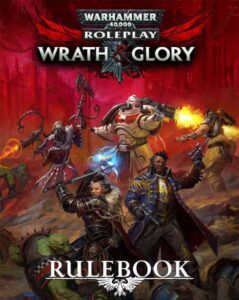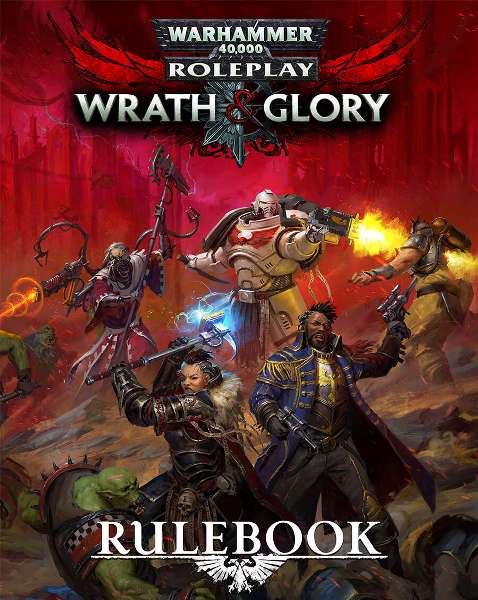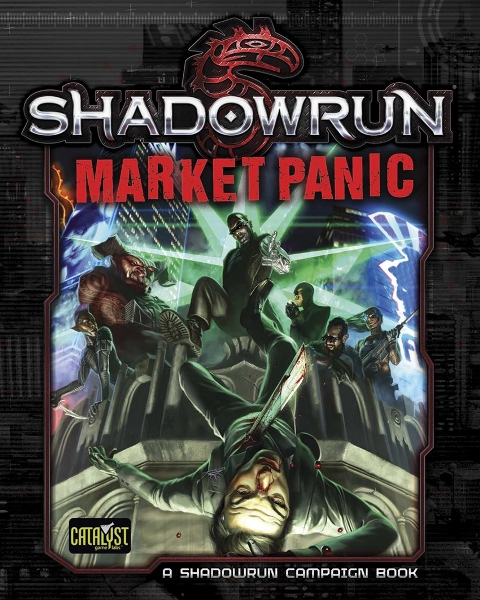
Wrath & Glory
Wrath & Glory is a gothic sci-fi role-playing game, set in Warhammer 40k, written by Zak Dale-Clutterbuck, Chris Handley, Eleanor Hingley, Elaine Lithgow, TS Luikart, Dominic McDowall, Jonathan Woodhouse and Ross Watson and published by Cubicle 7 Entertainment.
By Aaron T. Huss

Learn more about Wrath and Glory here
Purchase Wrath and Glory here (paid link)
Find other Warhammer 40k posts here
Before I get started, I want to note that I first approached Wrath & Glory thinking it was the replacement to Dark Heresy. That was a mistake and you should avoid that approach before proceeding.
Wrath & Glory is the most recent release product line for playing tabletop role-playing games within the realm of Warhammer 40k. It was originally developed by Ulisses North America and then taken over by Cubicle 7 Entertainment for what I understand was some much-needed revision. It is effectively an amalgamation of the concepts presented in Dark Heresy, Rogue Trader, Deathwatch, Black Crusade, and Only War wrapped into one book, stripped down, and presented as a single offering (I’ll go into that in more detail later). It is powered by a fairly generic dice pool system that scales along the different tiers of gameplay. It is 100% not compatible with the previous books and is effectively a new approach to all those systems with a lot of influence taken from the revisions that went into Dark Heresy 2nd Edition. One thing it does do is introduce the concept of creating a team working for a patron to achieve whatever that patron wants. This allows for the mash-up of character types covering the gambit of the Imperium and even a couple xenos types. Although the systematic approach takes influences from DH2E, the overall concept seems to mesh a little better with Rogue Trader where the rules of the Imperium are a bit more fluid.
Dark Heresy, 1st Edition, is literally my favorite role-playing game of all time. I own the entire library of non-free printed books and cannot get enough of the WH40k lore weaved throughout. With that said, I would never play Wrath & Glory because they basically turned it into Warhammer 40k Dungeons & Dragons (well, that’s what it feels like). Much of the spirit of WH40k has been completely stripped from the game outside of the factions and equipment. Whereas the lore of WH40k previously influenced the mechanics of all 5 games, it now is no more than a skin wrapped around a generic set of mechanics.
Keep in mind, that previous paragraph is merely my personal preference and now that it’s out of the way, let’s get into the good and bad of Wrath & Glory.
Wrath & Glory is kind of like a narrative skirmish game of the Warhammer 40k miniatures war game. There is a prominent action theme running throughout, placing the PCs squarely against the dangers of the galaxy. One of the positives of the game design is that no only does it scale as the characters level up, it scales from the very first game by presenting multiple tiers (four to be exact) to determine what level of adventure/campaign you wish to play. This is meant to a cooperative discussion between the players and the GM such that they determine the flavor of the game and what types of characters they wish to play. This then translates to a beginning tier, a suitable patron, and a collection of possible adventures that match those themes. The adventure supplements published by Cubicle 7 support that methodology with each one being optimal for a particular character level and patron type (only because the type of the patron generally drives the types of missions they will send the PCs on, but GMs can always break those rules). Keep in mind, there are plenty of great mechanics to level up the characters across the different tiers of play, the only catch is that if you start at Tier 1 you’ll have to succeed in many, many missions before reaching Tier 4.
Adding to the patron theme is the ability that Wrath & Glory provides that the previous five games do not. Patrons don’t have to conform to the whims of the Imperium (well, not all patrons that is; some, such as inquisitors, still should) opening the door for players to choose whatever character species (human, aeldari, or ork) and type they want (acolyte, rogue, soldier, psyker, space marine, etc.). It’s a true mash-up similar to if the patron was hiring a bunch of mercenaries on leave from their normal duties. This effectively maximizes the flexibility of the gameplay and replayability, enhancing the value of the single core rulebook.
The entirety of the game mechanics powering Wrath & Glory is based on scalability. Although the previous d100 system also scales, this one does so faster as smaller changes have a larger impact. The dice pool that powers that game is such that every die in the pool has a 50% chance of succeeding (although you still have to meet the target number of successes). For example, if your dice pool is 8 dice and an advancement provides +1 die, you have increased your chances of success by 12.5% (don’t quote my math here, it’s just an example). With the previous d100 system, an advance provides you +5 to +10, resulting in an increase of only 5-10%. Considering the percentage of improvement by adding a single die when you only have 4, you can see that the scaling advances quickly at first and then slows down the higher you go (because it’s not linear). The d100 system is linear and requires many more advances at those lower levels to reach the potential of a higher-tiered game (the d100 doesn’t call them tiers, but you get the point).
PCs aren’t the only scalable feature, so is the bestiary. The bestiary entries provide different stats for each Tier of play. I actually don’t like this because it makes an adversary seem like nothing more than a cookie cutter conflict rather than a specific threat that is only a threat at specific character levels. Non-scaling adversaries provide motivation to the PCs (and GM) to take on bigger and badder threats while scalable ones create somewhat meaningless encounters. Although I will state that it very likely makes the GM’s day easier as he or she will know what stats to use based on the PC’s Tier. This is likely only an issue for non-published adventures/campaigns.
The setting of Wrath & Glory is another new system (the Gilead System). Not really a surprise here as this is common throughout all the WH40k RPGs and creates new opportunities. However, there is a lot less lore in this core rulebook compared to the previous ones, but I won’t get into that.
The bulk of the core rulebook is dedicated to character creation, advancement, gear, conflict resolution, and tiered play. It’s not a very long book but provides all the basic rules to get you playing. Additionally, it’s possibly the only book players will ever need while GMs will want plenty more!
That’s the game you’re getting and I implore you to make your own decision. If you are looking for a high-action RPG set in the Warhammer 40k universe, then you should take a look. If you are looking for the type of game you got from Dark Heresy, which is more of an investigative sci-fi horror RPG, then stick to your old books.

